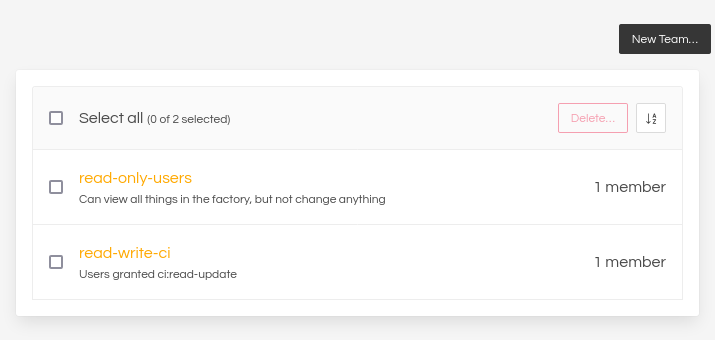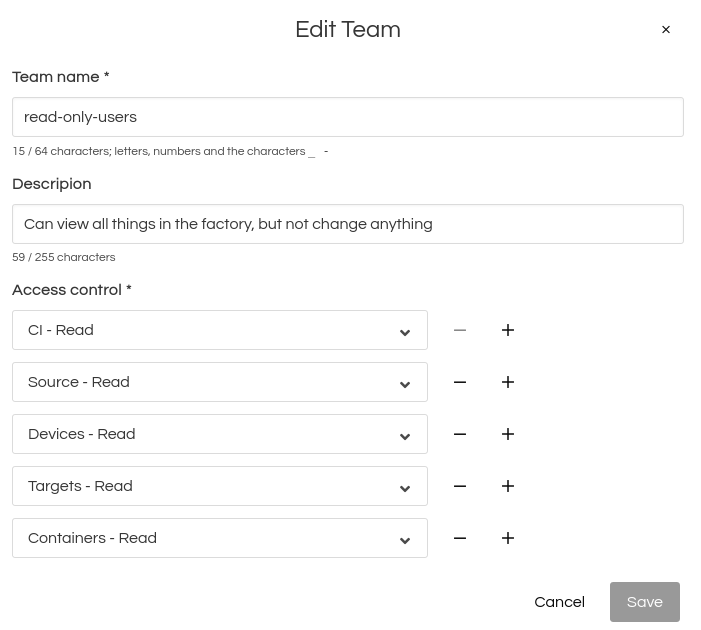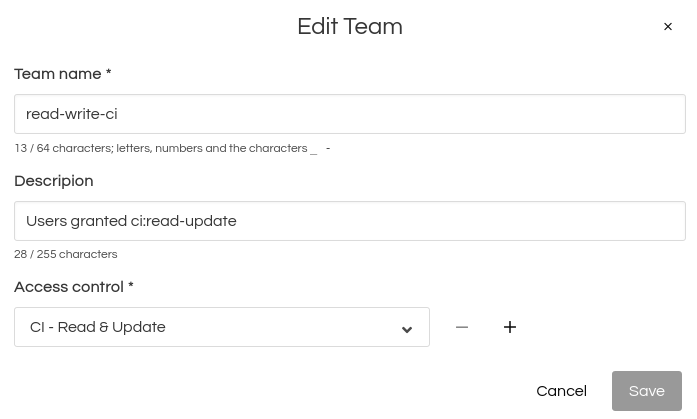Team Based Factory Access
See also
- Account Roles for account management.
- API Scopes for available token scopes.
Tip
The FoundriesFactory™ Platform API documentation covers available scopes.
Larger organizations often need to restrict the access level a user has to the Factory. For example, some users might only need access for managing devices, while other users only need read-only access to source code. Factory Teams is how FoundriesFactory enables you to control access.
A Team is comprised of:
- Access control: what scopes are granted to the team, e.g.
source:read.- Members: what users belong to the team.
- Device groups: what device groups belong to the team.
Once a user is assigned a team, their access will be limited to the scopes granted to that team. Also, a user will get access to the team’s device groups and their devices in accordance with the team scopes. See Team Based Access to Device Groups for more details.
Important
It may take a moment for changes to scope/teams to take effect.
Teams can be created by anyone with either the Owner or Admin role.
While these roles are granted read-write operations for all Factory resources by default,
checking user scope with fioctl users <user id> will return blank unless they are part of a team.
Members with devices may manage their own with read-write access.
Tip
You can always edit a Team, changing the name, description, or scope.
How it Works: Walk Through
API authorization can be thought of having the following decision tree:
- Is the user a member of the Factory this API is targeting?
- If yes, combine scopes of each team the user is a member of where:
- If scope was empty, the user can now access the resource.
- If not empty, the authorization code asserts the user now has the required scope.
Example
A Factory has two teams in place. Team “read-only-users” is restricted to read-only access; members can see everything, but can not make changes. Team “read-write-ci” can do CI read-write operations:

A member is then added to both teams. The member then has a combined list of scopes:
- From read-only-users:
- ci:read
- source:read
- devices:read
- targets:read
- containers:read
- From read-write-ci
- ci:read-update
The user now has read and write (update) access to the CI, while retaining the read-only scopes for the other resources.
Team Based Access to Device Groups
By default, a user can access:
- device groups they created,
- devices they own,
- devices that are in device groups they created.
A factory admin can grant a user access to any device groups. To do so, an admin should:
- add a user to a team if is not a team member yet;
- add a device group to the team;
- set
devices:*scopes for the team.
As a result, the user will get a permission to perform the set actions over the group and its devices.
Note
The devices:* scopes determine actions team members can perform over device groups and their devices.
devices:read- view device/group details and its configuration.devices:read-update- view and modify device/group details and its configuration, including config file deletion.devices:delete- delete device/group.
See API Scopes for more details on the scopes.
Example
A Factory has two teams in place and one device group, test-lab-devices.
Members of the “read-only-users” team have read-only access to all factory resources with one exception—device groups and devices.
They can see only the test-lab-devices group and devices included into it.

The “lab-dev-users” team includes devices:read-update scope.
Therefore, members of this team can modify the test-lab-devices group and its devices.

Changes to TUF Root
With Fioctl® v0.35 and newer, if someone makes changes to TUF root, others will be required to upgrade to the same version if they wish to make changes. This is to prevent accidental eraser of the TUF keys ownership information.
See also

